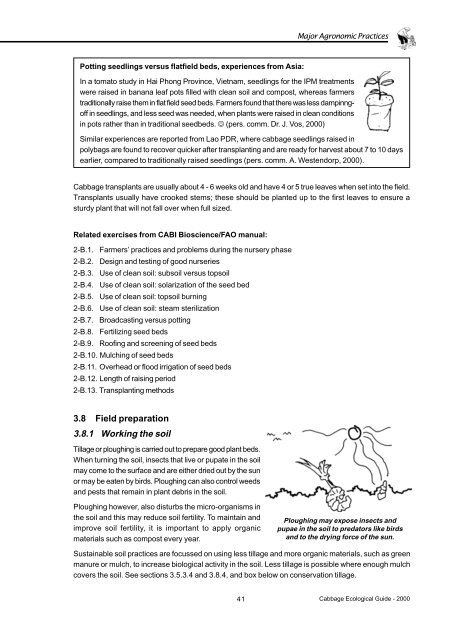Cabbage Integrated Pest Management : An Ecological Guide.
Cabbage Integrated Pest Management : An Ecological Guide.
Cabbage Integrated Pest Management : An Ecological Guide.
Create successful ePaper yourself
Turn your PDF publications into a flip-book with our unique Google optimized e-Paper software.
Major Agronomic PracticesPotting seedlings versus flatfield beds, experiences from Asia:In a tomato study in Hai Phong Province, Vietnam, seedlings for the IPM treatmentswere raised in banana leaf pots filled with clean soil and compost, whereas farmerstraditionally raise them in flat field seed beds. Farmers found that there was less dampinngoffin seedlings, and less seed was needed, when plants were raised in clean conditionsin pots rather than in traditional seedbeds. J (pers. comm. Dr. J. Vos, 2000)Similar experiences are reported from Lao PDR, where cabbage seedlings raised inpolybags are found to recover quicker after transplanting and are ready for harvest about 7 to 10 daysearlier, compared to traditionally raised seedlings (pers. comm. A. Westendorp, 2000).<strong>Cabbage</strong> transplants are usually about 4 - 6 weeks old and have 4 or 5 true leaves when set into the field.Transplants usually have crooked stems; these should be planted up to the first leaves to ensure asturdy plant that will not fall over when full sized.Related exercises from CABI Bioscience/FAO manual:2-B.1. Farmers’ practices and problems during the nursery phase2-B.2. Design and testing of good nurseries2-B.3. Use of clean soil: subsoil versus topsoil2-B.4. Use of clean soil: solarization of the seed bed2-B.5. Use of clean soil: topsoil burning2-B.6. Use of clean soil: steam sterilization2-B.7. Broadcasting versus potting2-B.8. Fertilizing seed beds2-B.9. Roofing and screening of seed beds2-B.10. Mulching of seed beds2-B.11. Overhead or flood irrigation of seed beds2-B.12. Length of raising period2-B.13. Transplanting methods3.8 Field preparation3.8.1 Working the soilTillage or ploughing is carried out to prepare good plant beds.When turning the soil, insects that live or pupate in the soilmay come to the surface and are either dried out by the sunor may be eaten by birds. Ploughing can also control weedsand pests that remain in plant debris in the soil.Ploughing however, also disturbs the micro-organisms inthe soil and this may reduce soil fertility. To maintain andimprove soil fertility, it is important to apply organicmaterials such as compost every year.Ploughing may expose insects andpupae in the soil to predators like birdsand to the drying force of the sun.Sustainable soil practices are focussed on using less tillage and more organic materials, such as greenmanure or mulch, to increase biological activity in the soil. Less tillage is possible where enough mulchcovers the soil. See sections 3.5.3.4 and 3.8.4, and box below on conservation tillage.41 <strong>Cabbage</strong> <strong>Ecological</strong> <strong>Guide</strong> - 2000




![Section 4 [ PDF file, 252 KB] - The Field Alliance](https://img.yumpu.com/51387260/1/158x260/section-4-pdf-file-252-kb-the-field-alliance.jpg?quality=85)











